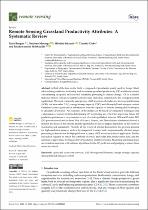| dc.contributor.author | Bangira, Tsitsi | |
| dc.contributor.author | Mutanga, Onisimo | |
| dc.contributor.author | Sibanda, Mbulisi | |
| dc.contributor.author | Dube, Timothy | |
| dc.contributor.author | Mabhaudhi, Tafadzwanashe | |
| dc.date.accessioned | 2023-05-16T09:02:38Z | |
| dc.date.available | 2023-05-16T09:02:38Z | |
| dc.date.issued | 2023 | |
| dc.identifier.citation | Bangira, T., Mutanga, O., Sibanda, M., Dube, T., & Mabhaudhi, T. (2023). Remote sensing grassland productivity attributes: A systematic review. Remote Sensing, 15(8) doi:10.3390/rs15082043 | en_US |
| dc.identifier.uri | https://doi.org/10.3390/rs15082043 | |
| dc.identifier.uri | http://hdl.handle.net/10566/8913 | |
| dc.description.abstract | A third of the land on the Earth is composed of grasslands, mainly used for forage. Much effort is being conducted to develop tools to estimate grassland productivity (GP) at different extents, concentrating on spatial and seasonal variability pertaining to climate change. GP is a reliable indicator of how well an ecosystem works because of its close connection to the ecological system equilibrium. The most commonly used proxies of GP in ecological studies are aboveground biomass (AGB), leaf area index (LAI), canopy storage capacity (CSC), and chlorophyll and nitrogen content. Grassland science gains much information from the capacity of remote sensing (RS) techniques to calculate GP proxies. An overview of the studies on RS-based GP prediction techniques and a discussion of current matters determining GP monitoring are critical for improving future GP prediction performance. A systematic review of articles published between 1970 and October 2021 (203 peer-reviewed articles from Web of Science, Scopus, and DirectScience databases) showed a trend in the choice of the sensors, and the approaches to use are largely dependent on the extent of monitoring and assessment. Notably, all the reviewed articles demonstrate the growing demand for high-resolution sensors, such as hyperspectral scanners and computationally efficient image-processing techniques for the high prediction accuracy of GP at various scales of application. Further research is required to attract the synthesis of optical and radar data, multi-sensor data, and the selection of appropriate techniques for GP prediction at different scales. Mastering and listing major uncertainties associated with different algorithms for the GP prediction and pledging to reduce these errors are critical. | en_US |
| dc.language.iso | en | en_US |
| dc.publisher | MDPI | en_US |
| dc.subject | Aboveground biomass | en_US |
| dc.subject | Canopy storage capacity | en_US |
| dc.subject | Chlorophyll and nitrogen content | en_US |
| dc.subject | Grassland ecosystem services | en_US |
| dc.title | Remote Sensing Grassland Productivity Attributes: A Systematic Review | en_US |
| dc.type | Article | en_US |

